Management Accounting: Systems, Reporting, and Problem Analysis
VerifiedAdded on 2020/06/04
|13
|4037
|148
Report
AI Summary
This report provides an analysis of management accounting and its importance in organizational decision-making. It examines various management accounting systems and reporting methods, including job cost reports, performance reports, account receivable reports, and inventory management reports. The report also discusses different cost accounting systems, such as absorption costing and marginal costing, used to evaluate net profit. Furthermore, it explores the benefits and disadvantages of planning tools used in budgetary control and analyzes financial problems and measures to overcome them, offering a comprehensive overview of management accounting techniques and their practical applications in managing business operations and finances.
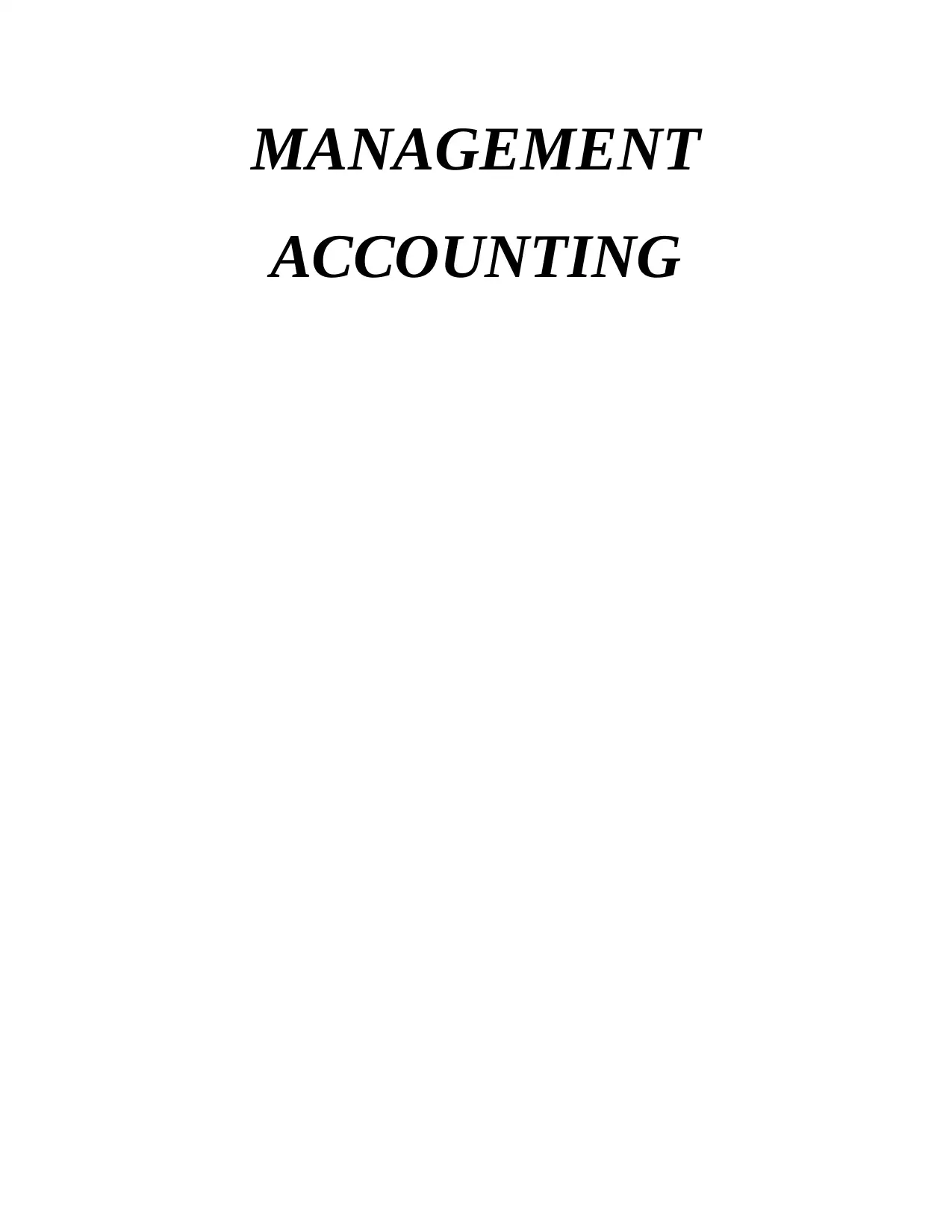
MANAGEMENT
ACCOUNTING
ACCOUNTING
Paraphrase This Document
Need a fresh take? Get an instant paraphrase of this document with our AI Paraphraser
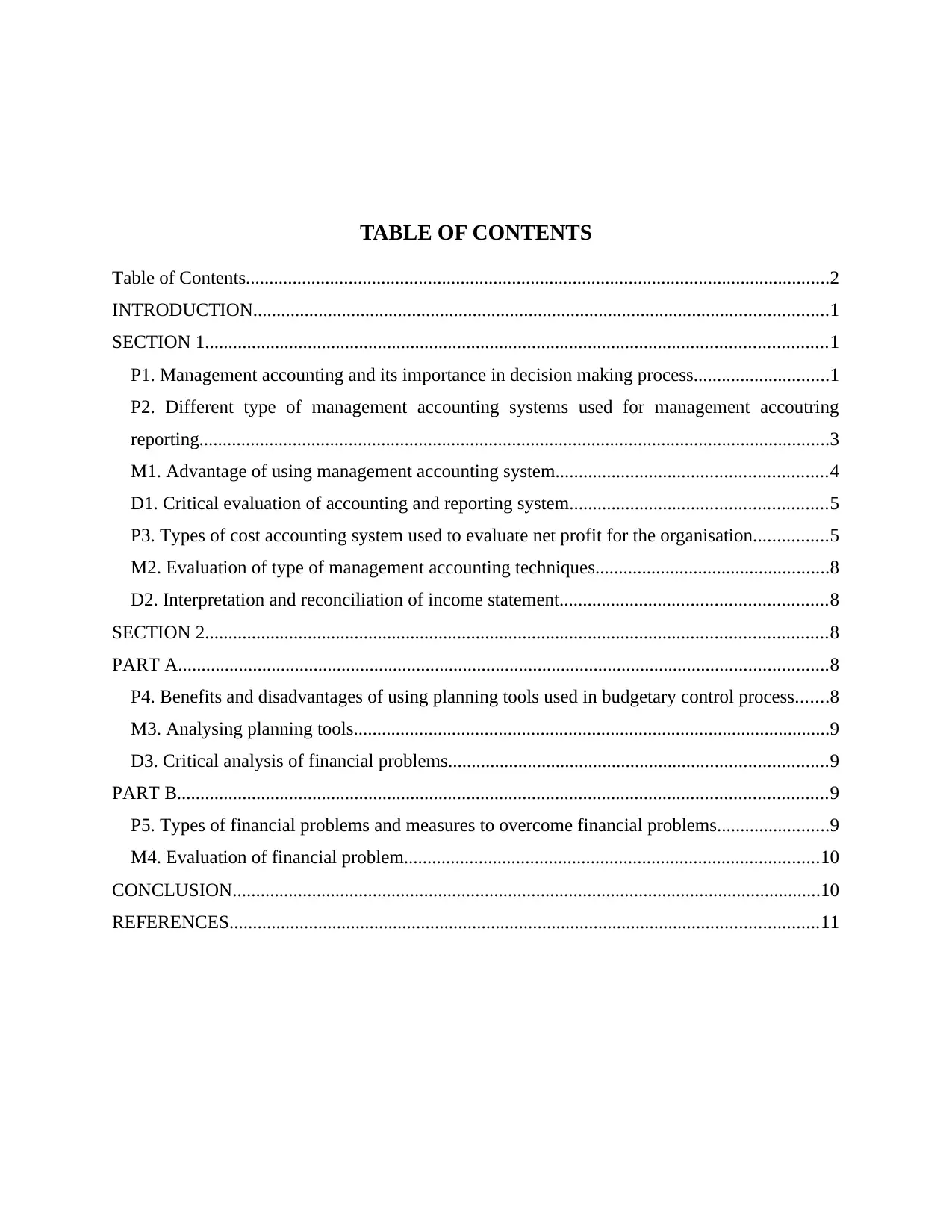
TABLE OF CONTENTS
Table of Contents.............................................................................................................................2
INTRODUCTION...........................................................................................................................1
SECTION 1.....................................................................................................................................1
P1. Management accounting and its importance in decision making process.............................1
P2. Different type of management accounting systems used for management accoutring
reporting.......................................................................................................................................3
M1. Advantage of using management accounting system..........................................................4
D1. Critical evaluation of accounting and reporting system.......................................................5
P3. Types of cost accounting system used to evaluate net profit for the organisation................5
M2. Evaluation of type of management accounting techniques..................................................8
D2. Interpretation and reconciliation of income statement.........................................................8
SECTION 2.....................................................................................................................................8
PART A...........................................................................................................................................8
P4. Benefits and disadvantages of using planning tools used in budgetary control process.......8
M3. Analysing planning tools......................................................................................................9
D3. Critical analysis of financial problems.................................................................................9
PART B...........................................................................................................................................9
P5. Types of financial problems and measures to overcome financial problems........................9
M4. Evaluation of financial problem.........................................................................................10
CONCLUSION..............................................................................................................................10
REFERENCES..............................................................................................................................11
Table of Contents.............................................................................................................................2
INTRODUCTION...........................................................................................................................1
SECTION 1.....................................................................................................................................1
P1. Management accounting and its importance in decision making process.............................1
P2. Different type of management accounting systems used for management accoutring
reporting.......................................................................................................................................3
M1. Advantage of using management accounting system..........................................................4
D1. Critical evaluation of accounting and reporting system.......................................................5
P3. Types of cost accounting system used to evaluate net profit for the organisation................5
M2. Evaluation of type of management accounting techniques..................................................8
D2. Interpretation and reconciliation of income statement.........................................................8
SECTION 2.....................................................................................................................................8
PART A...........................................................................................................................................8
P4. Benefits and disadvantages of using planning tools used in budgetary control process.......8
M3. Analysing planning tools......................................................................................................9
D3. Critical analysis of financial problems.................................................................................9
PART B...........................................................................................................................................9
P5. Types of financial problems and measures to overcome financial problems........................9
M4. Evaluation of financial problem.........................................................................................10
CONCLUSION..............................................................................................................................10
REFERENCES..............................................................................................................................11
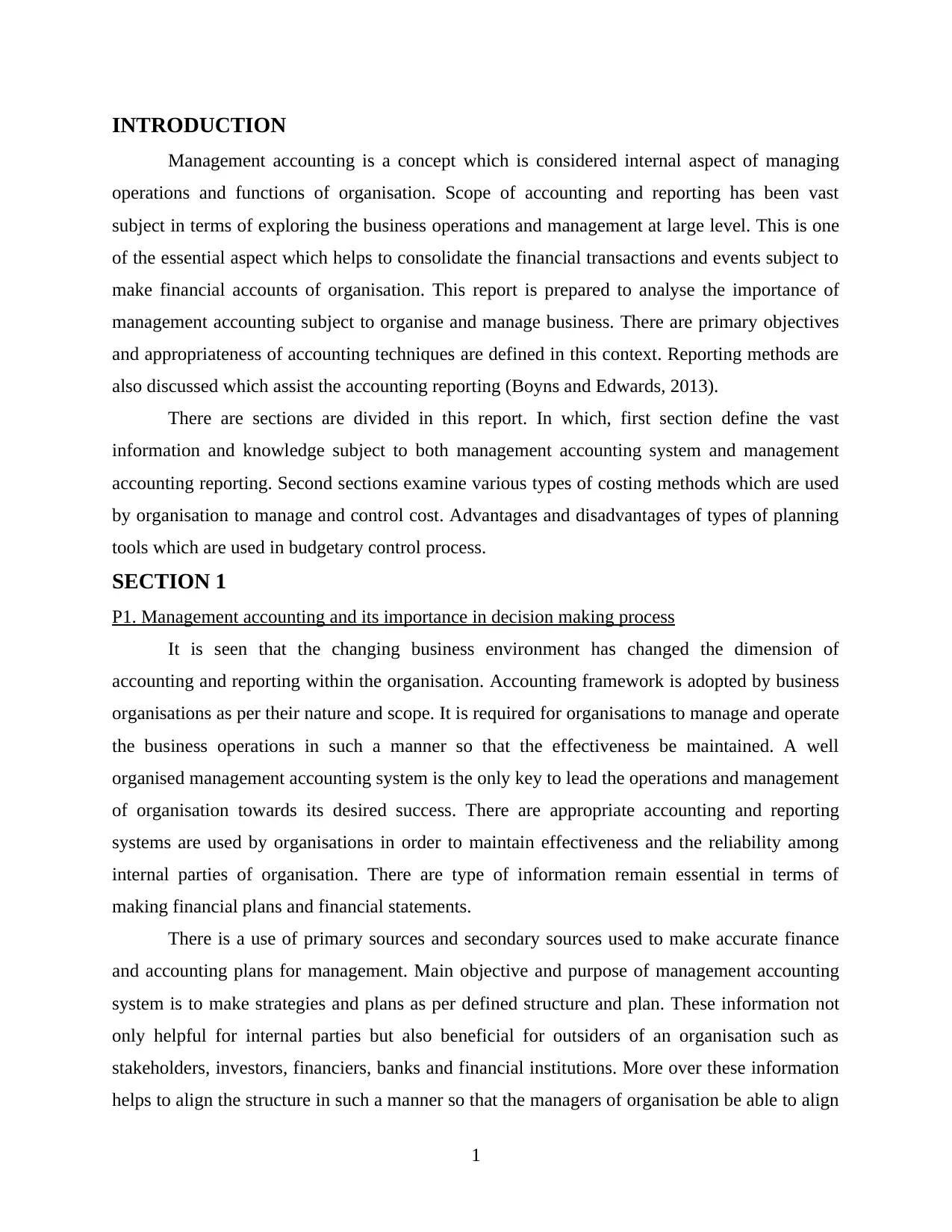
INTRODUCTION
Management accounting is a concept which is considered internal aspect of managing
operations and functions of organisation. Scope of accounting and reporting has been vast
subject in terms of exploring the business operations and management at large level. This is one
of the essential aspect which helps to consolidate the financial transactions and events subject to
make financial accounts of organisation. This report is prepared to analyse the importance of
management accounting subject to organise and manage business. There are primary objectives
and appropriateness of accounting techniques are defined in this context. Reporting methods are
also discussed which assist the accounting reporting (Boyns and Edwards, 2013).
There are sections are divided in this report. In which, first section define the vast
information and knowledge subject to both management accounting system and management
accounting reporting. Second sections examine various types of costing methods which are used
by organisation to manage and control cost. Advantages and disadvantages of types of planning
tools which are used in budgetary control process.
SECTION 1
P1. Management accounting and its importance in decision making process
It is seen that the changing business environment has changed the dimension of
accounting and reporting within the organisation. Accounting framework is adopted by business
organisations as per their nature and scope. It is required for organisations to manage and operate
the business operations in such a manner so that the effectiveness be maintained. A well
organised management accounting system is the only key to lead the operations and management
of organisation towards its desired success. There are appropriate accounting and reporting
systems are used by organisations in order to maintain effectiveness and the reliability among
internal parties of organisation. There are type of information remain essential in terms of
making financial plans and financial statements.
There is a use of primary sources and secondary sources used to make accurate finance
and accounting plans for management. Main objective and purpose of management accounting
system is to make strategies and plans as per defined structure and plan. These information not
only helpful for internal parties but also beneficial for outsiders of an organisation such as
stakeholders, investors, financiers, banks and financial institutions. More over these information
helps to align the structure in such a manner so that the managers of organisation be able to align
1
Management accounting is a concept which is considered internal aspect of managing
operations and functions of organisation. Scope of accounting and reporting has been vast
subject in terms of exploring the business operations and management at large level. This is one
of the essential aspect which helps to consolidate the financial transactions and events subject to
make financial accounts of organisation. This report is prepared to analyse the importance of
management accounting subject to organise and manage business. There are primary objectives
and appropriateness of accounting techniques are defined in this context. Reporting methods are
also discussed which assist the accounting reporting (Boyns and Edwards, 2013).
There are sections are divided in this report. In which, first section define the vast
information and knowledge subject to both management accounting system and management
accounting reporting. Second sections examine various types of costing methods which are used
by organisation to manage and control cost. Advantages and disadvantages of types of planning
tools which are used in budgetary control process.
SECTION 1
P1. Management accounting and its importance in decision making process
It is seen that the changing business environment has changed the dimension of
accounting and reporting within the organisation. Accounting framework is adopted by business
organisations as per their nature and scope. It is required for organisations to manage and operate
the business operations in such a manner so that the effectiveness be maintained. A well
organised management accounting system is the only key to lead the operations and management
of organisation towards its desired success. There are appropriate accounting and reporting
systems are used by organisations in order to maintain effectiveness and the reliability among
internal parties of organisation. There are type of information remain essential in terms of
making financial plans and financial statements.
There is a use of primary sources and secondary sources used to make accurate finance
and accounting plans for management. Main objective and purpose of management accounting
system is to make strategies and plans as per defined structure and plan. These information not
only helpful for internal parties but also beneficial for outsiders of an organisation such as
stakeholders, investors, financiers, banks and financial institutions. More over these information
helps to align the structure in such a manner so that the managers of organisation be able to align
1
⊘ This is a preview!⊘
Do you want full access?
Subscribe today to unlock all pages.

Trusted by 1+ million students worldwide
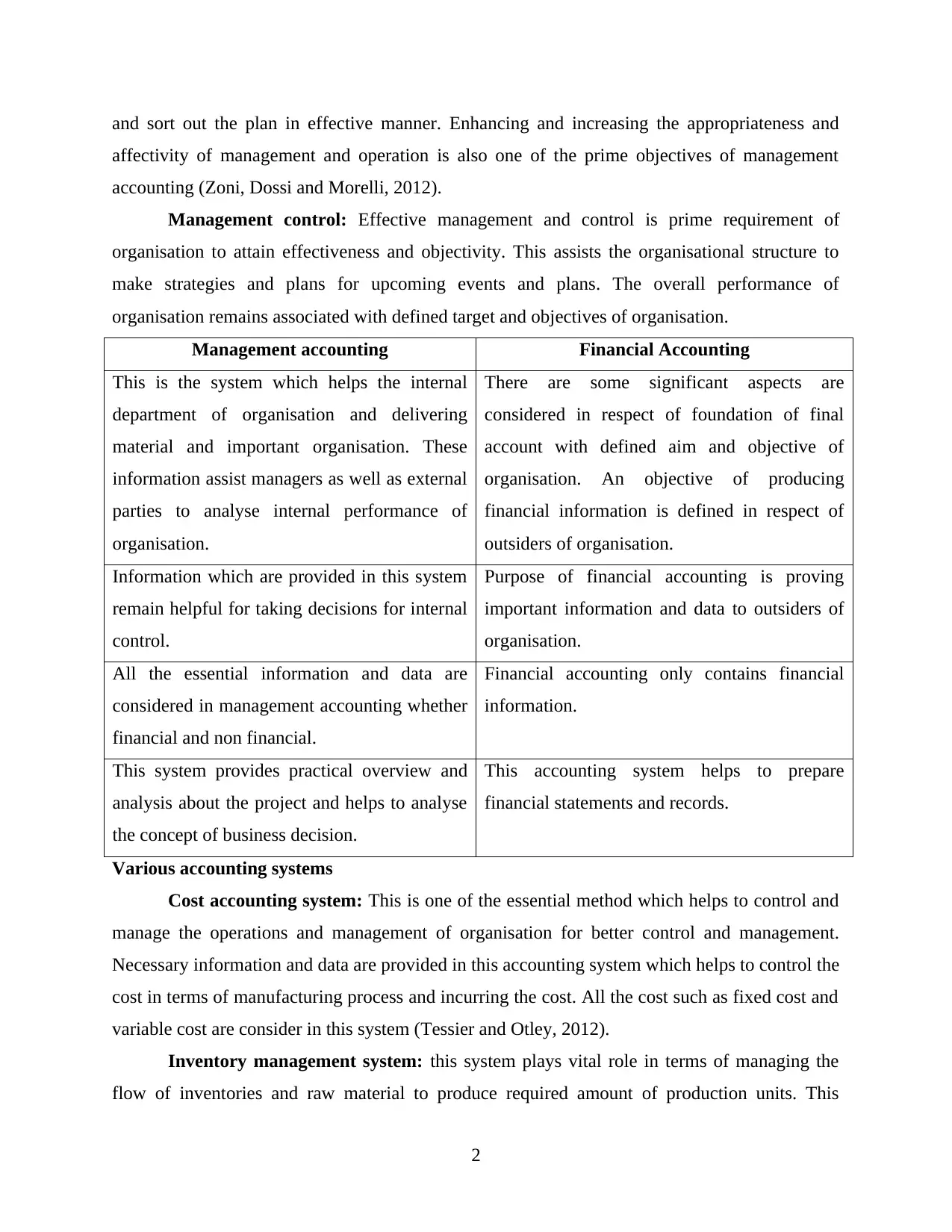
and sort out the plan in effective manner. Enhancing and increasing the appropriateness and
affectivity of management and operation is also one of the prime objectives of management
accounting (Zoni, Dossi and Morelli, 2012).
Management control: Effective management and control is prime requirement of
organisation to attain effectiveness and objectivity. This assists the organisational structure to
make strategies and plans for upcoming events and plans. The overall performance of
organisation remains associated with defined target and objectives of organisation.
Management accounting Financial Accounting
This is the system which helps the internal
department of organisation and delivering
material and important organisation. These
information assist managers as well as external
parties to analyse internal performance of
organisation.
There are some significant aspects are
considered in respect of foundation of final
account with defined aim and objective of
organisation. An objective of producing
financial information is defined in respect of
outsiders of organisation.
Information which are provided in this system
remain helpful for taking decisions for internal
control.
Purpose of financial accounting is proving
important information and data to outsiders of
organisation.
All the essential information and data are
considered in management accounting whether
financial and non financial.
Financial accounting only contains financial
information.
This system provides practical overview and
analysis about the project and helps to analyse
the concept of business decision.
This accounting system helps to prepare
financial statements and records.
Various accounting systems
Cost accounting system: This is one of the essential method which helps to control and
manage the operations and management of organisation for better control and management.
Necessary information and data are provided in this accounting system which helps to control the
cost in terms of manufacturing process and incurring the cost. All the cost such as fixed cost and
variable cost are consider in this system (Tessier and Otley, 2012).
Inventory management system: this system plays vital role in terms of managing the
flow of inventories and raw material to produce required amount of production units. This
2
affectivity of management and operation is also one of the prime objectives of management
accounting (Zoni, Dossi and Morelli, 2012).
Management control: Effective management and control is prime requirement of
organisation to attain effectiveness and objectivity. This assists the organisational structure to
make strategies and plans for upcoming events and plans. The overall performance of
organisation remains associated with defined target and objectives of organisation.
Management accounting Financial Accounting
This is the system which helps the internal
department of organisation and delivering
material and important organisation. These
information assist managers as well as external
parties to analyse internal performance of
organisation.
There are some significant aspects are
considered in respect of foundation of final
account with defined aim and objective of
organisation. An objective of producing
financial information is defined in respect of
outsiders of organisation.
Information which are provided in this system
remain helpful for taking decisions for internal
control.
Purpose of financial accounting is proving
important information and data to outsiders of
organisation.
All the essential information and data are
considered in management accounting whether
financial and non financial.
Financial accounting only contains financial
information.
This system provides practical overview and
analysis about the project and helps to analyse
the concept of business decision.
This accounting system helps to prepare
financial statements and records.
Various accounting systems
Cost accounting system: This is one of the essential method which helps to control and
manage the operations and management of organisation for better control and management.
Necessary information and data are provided in this accounting system which helps to control the
cost in terms of manufacturing process and incurring the cost. All the cost such as fixed cost and
variable cost are consider in this system (Tessier and Otley, 2012).
Inventory management system: this system plays vital role in terms of managing the
flow of inventories and raw material to produce required amount of production units. This
2
Paraphrase This Document
Need a fresh take? Get an instant paraphrase of this document with our AI Paraphraser
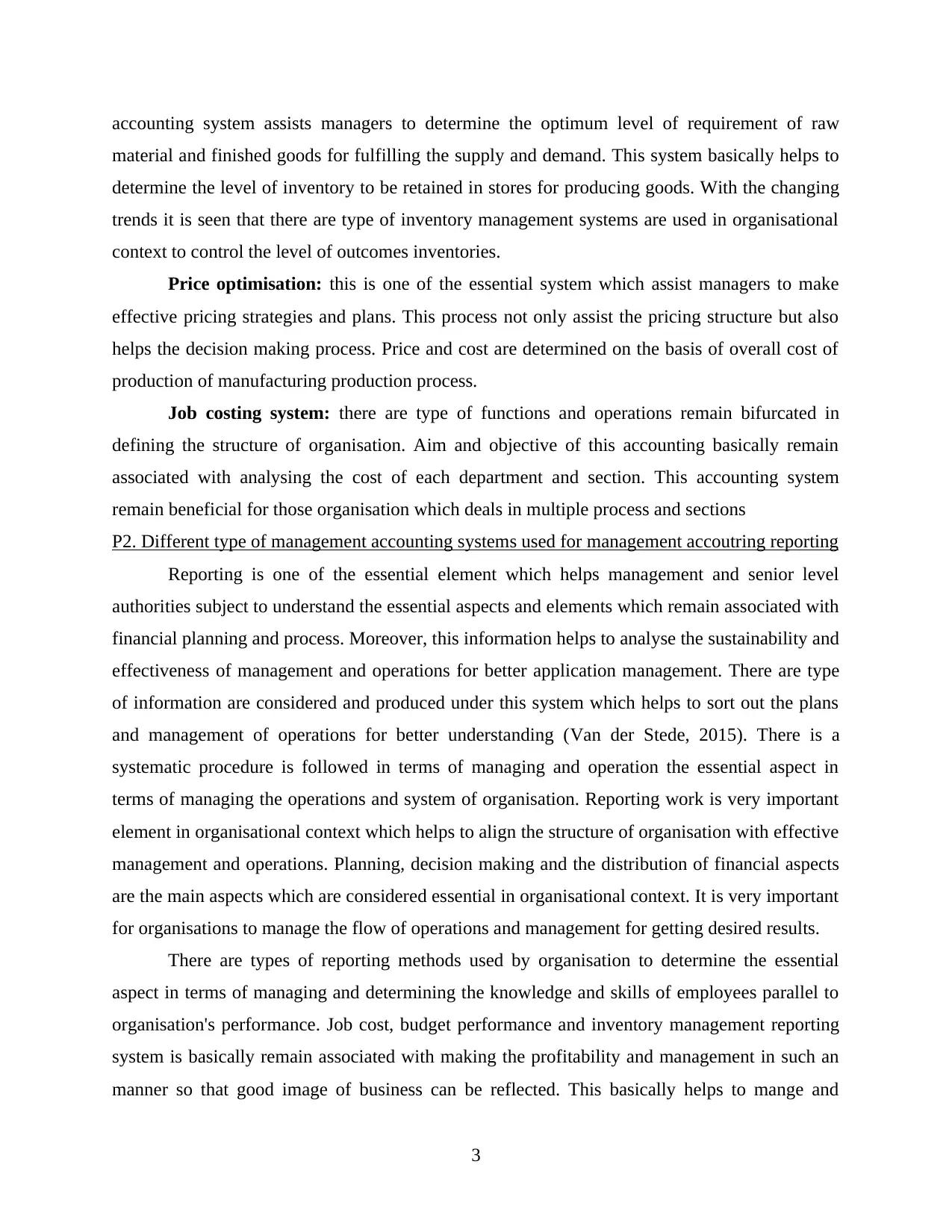
accounting system assists managers to determine the optimum level of requirement of raw
material and finished goods for fulfilling the supply and demand. This system basically helps to
determine the level of inventory to be retained in stores for producing goods. With the changing
trends it is seen that there are type of inventory management systems are used in organisational
context to control the level of outcomes inventories.
Price optimisation: this is one of the essential system which assist managers to make
effective pricing strategies and plans. This process not only assist the pricing structure but also
helps the decision making process. Price and cost are determined on the basis of overall cost of
production of manufacturing production process.
Job costing system: there are type of functions and operations remain bifurcated in
defining the structure of organisation. Aim and objective of this accounting basically remain
associated with analysing the cost of each department and section. This accounting system
remain beneficial for those organisation which deals in multiple process and sections
P2. Different type of management accounting systems used for management accoutring reporting
Reporting is one of the essential element which helps management and senior level
authorities subject to understand the essential aspects and elements which remain associated with
financial planning and process. Moreover, this information helps to analyse the sustainability and
effectiveness of management and operations for better application management. There are type
of information are considered and produced under this system which helps to sort out the plans
and management of operations for better understanding (Van der Stede, 2015). There is a
systematic procedure is followed in terms of managing and operation the essential aspect in
terms of managing the operations and system of organisation. Reporting work is very important
element in organisational context which helps to align the structure of organisation with effective
management and operations. Planning, decision making and the distribution of financial aspects
are the main aspects which are considered essential in organisational context. It is very important
for organisations to manage the flow of operations and management for getting desired results.
There are types of reporting methods used by organisation to determine the essential
aspect in terms of managing and determining the knowledge and skills of employees parallel to
organisation's performance. Job cost, budget performance and inventory management reporting
system is basically remain associated with making the profitability and management in such an
manner so that good image of business can be reflected. This basically helps to mange and
3
material and finished goods for fulfilling the supply and demand. This system basically helps to
determine the level of inventory to be retained in stores for producing goods. With the changing
trends it is seen that there are type of inventory management systems are used in organisational
context to control the level of outcomes inventories.
Price optimisation: this is one of the essential system which assist managers to make
effective pricing strategies and plans. This process not only assist the pricing structure but also
helps the decision making process. Price and cost are determined on the basis of overall cost of
production of manufacturing production process.
Job costing system: there are type of functions and operations remain bifurcated in
defining the structure of organisation. Aim and objective of this accounting basically remain
associated with analysing the cost of each department and section. This accounting system
remain beneficial for those organisation which deals in multiple process and sections
P2. Different type of management accounting systems used for management accoutring reporting
Reporting is one of the essential element which helps management and senior level
authorities subject to understand the essential aspects and elements which remain associated with
financial planning and process. Moreover, this information helps to analyse the sustainability and
effectiveness of management and operations for better application management. There are type
of information are considered and produced under this system which helps to sort out the plans
and management of operations for better understanding (Van der Stede, 2015). There is a
systematic procedure is followed in terms of managing and operation the essential aspect in
terms of managing the operations and system of organisation. Reporting work is very important
element in organisational context which helps to align the structure of organisation with effective
management and operations. Planning, decision making and the distribution of financial aspects
are the main aspects which are considered essential in organisational context. It is very important
for organisations to manage the flow of operations and management for getting desired results.
There are types of reporting methods used by organisation to determine the essential
aspect in terms of managing and determining the knowledge and skills of employees parallel to
organisation's performance. Job cost, budget performance and inventory management reporting
system is basically remain associated with making the profitability and management in such an
manner so that good image of business can be reflected. This basically helps to mange and
3
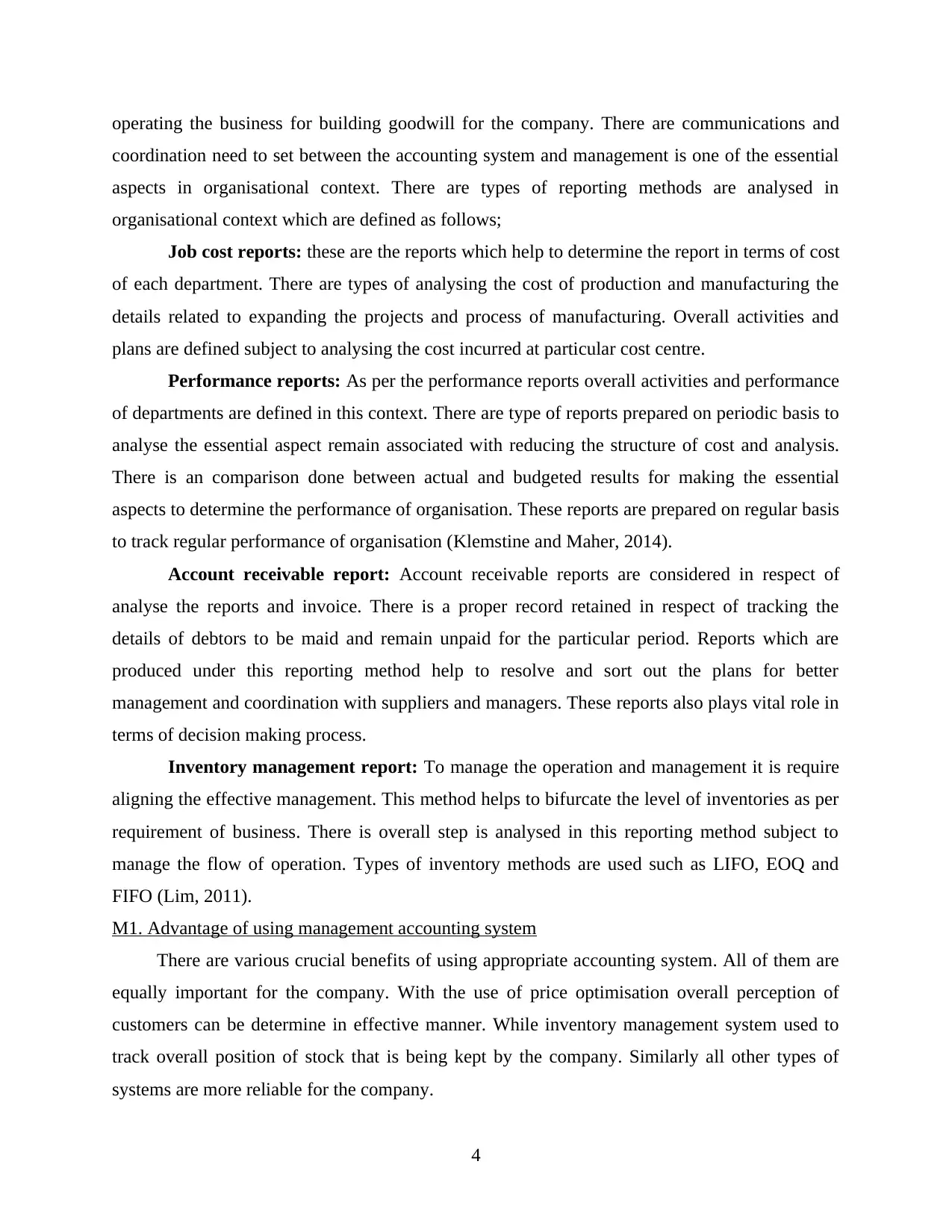
operating the business for building goodwill for the company. There are communications and
coordination need to set between the accounting system and management is one of the essential
aspects in organisational context. There are types of reporting methods are analysed in
organisational context which are defined as follows;
Job cost reports: these are the reports which help to determine the report in terms of cost
of each department. There are types of analysing the cost of production and manufacturing the
details related to expanding the projects and process of manufacturing. Overall activities and
plans are defined subject to analysing the cost incurred at particular cost centre.
Performance reports: As per the performance reports overall activities and performance
of departments are defined in this context. There are type of reports prepared on periodic basis to
analyse the essential aspect remain associated with reducing the structure of cost and analysis.
There is an comparison done between actual and budgeted results for making the essential
aspects to determine the performance of organisation. These reports are prepared on regular basis
to track regular performance of organisation (Klemstine and Maher, 2014).
Account receivable report: Account receivable reports are considered in respect of
analyse the reports and invoice. There is a proper record retained in respect of tracking the
details of debtors to be maid and remain unpaid for the particular period. Reports which are
produced under this reporting method help to resolve and sort out the plans for better
management and coordination with suppliers and managers. These reports also plays vital role in
terms of decision making process.
Inventory management report: To manage the operation and management it is require
aligning the effective management. This method helps to bifurcate the level of inventories as per
requirement of business. There is overall step is analysed in this reporting method subject to
manage the flow of operation. Types of inventory methods are used such as LIFO, EOQ and
FIFO (Lim, 2011).
M1. Advantage of using management accounting system
There are various crucial benefits of using appropriate accounting system. All of them are
equally important for the company. With the use of price optimisation overall perception of
customers can be determine in effective manner. While inventory management system used to
track overall position of stock that is being kept by the company. Similarly all other types of
systems are more reliable for the company.
4
coordination need to set between the accounting system and management is one of the essential
aspects in organisational context. There are types of reporting methods are analysed in
organisational context which are defined as follows;
Job cost reports: these are the reports which help to determine the report in terms of cost
of each department. There are types of analysing the cost of production and manufacturing the
details related to expanding the projects and process of manufacturing. Overall activities and
plans are defined subject to analysing the cost incurred at particular cost centre.
Performance reports: As per the performance reports overall activities and performance
of departments are defined in this context. There are type of reports prepared on periodic basis to
analyse the essential aspect remain associated with reducing the structure of cost and analysis.
There is an comparison done between actual and budgeted results for making the essential
aspects to determine the performance of organisation. These reports are prepared on regular basis
to track regular performance of organisation (Klemstine and Maher, 2014).
Account receivable report: Account receivable reports are considered in respect of
analyse the reports and invoice. There is a proper record retained in respect of tracking the
details of debtors to be maid and remain unpaid for the particular period. Reports which are
produced under this reporting method help to resolve and sort out the plans for better
management and coordination with suppliers and managers. These reports also plays vital role in
terms of decision making process.
Inventory management report: To manage the operation and management it is require
aligning the effective management. This method helps to bifurcate the level of inventories as per
requirement of business. There is overall step is analysed in this reporting method subject to
manage the flow of operation. Types of inventory methods are used such as LIFO, EOQ and
FIFO (Lim, 2011).
M1. Advantage of using management accounting system
There are various crucial benefits of using appropriate accounting system. All of them are
equally important for the company. With the use of price optimisation overall perception of
customers can be determine in effective manner. While inventory management system used to
track overall position of stock that is being kept by the company. Similarly all other types of
systems are more reliable for the company.
4
⊘ This is a preview!⊘
Do you want full access?
Subscribe today to unlock all pages.

Trusted by 1+ million students worldwide
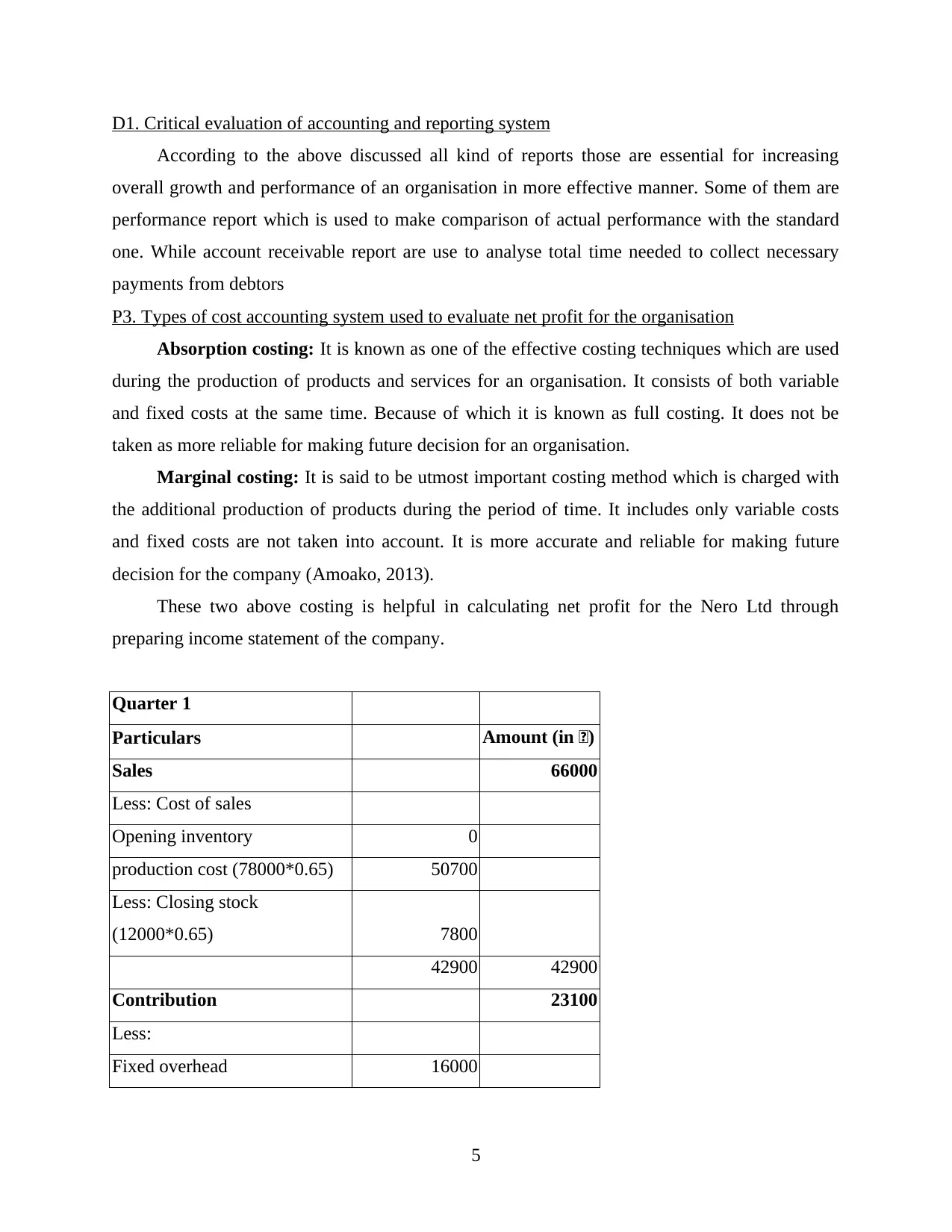
D1. Critical evaluation of accounting and reporting system
According to the above discussed all kind of reports those are essential for increasing
overall growth and performance of an organisation in more effective manner. Some of them are
performance report which is used to make comparison of actual performance with the standard
one. While account receivable report are use to analyse total time needed to collect necessary
payments from debtors
P3. Types of cost accounting system used to evaluate net profit for the organisation
Absorption costing: It is known as one of the effective costing techniques which are used
during the production of products and services for an organisation. It consists of both variable
and fixed costs at the same time. Because of which it is known as full costing. It does not be
taken as more reliable for making future decision for an organisation.
Marginal costing: It is said to be utmost important costing method which is charged with
the additional production of products during the period of time. It includes only variable costs
and fixed costs are not taken into account. It is more accurate and reliable for making future
decision for the company (Amoako, 2013).
These two above costing is helpful in calculating net profit for the Nero Ltd through
preparing income statement of the company.
Quarter 1
Particulars Amount (in £)
Sales 66000
Less: Cost of sales
Opening inventory 0
production cost (78000*0.65) 50700
Less: Closing stock
(12000*0.65) 7800
42900 42900
Contribution 23100
Less:
Fixed overhead 16000
5
According to the above discussed all kind of reports those are essential for increasing
overall growth and performance of an organisation in more effective manner. Some of them are
performance report which is used to make comparison of actual performance with the standard
one. While account receivable report are use to analyse total time needed to collect necessary
payments from debtors
P3. Types of cost accounting system used to evaluate net profit for the organisation
Absorption costing: It is known as one of the effective costing techniques which are used
during the production of products and services for an organisation. It consists of both variable
and fixed costs at the same time. Because of which it is known as full costing. It does not be
taken as more reliable for making future decision for an organisation.
Marginal costing: It is said to be utmost important costing method which is charged with
the additional production of products during the period of time. It includes only variable costs
and fixed costs are not taken into account. It is more accurate and reliable for making future
decision for the company (Amoako, 2013).
These two above costing is helpful in calculating net profit for the Nero Ltd through
preparing income statement of the company.
Quarter 1
Particulars Amount (in £)
Sales 66000
Less: Cost of sales
Opening inventory 0
production cost (78000*0.65) 50700
Less: Closing stock
(12000*0.65) 7800
42900 42900
Contribution 23100
Less:
Fixed overhead 16000
5
Paraphrase This Document
Need a fresh take? Get an instant paraphrase of this document with our AI Paraphraser
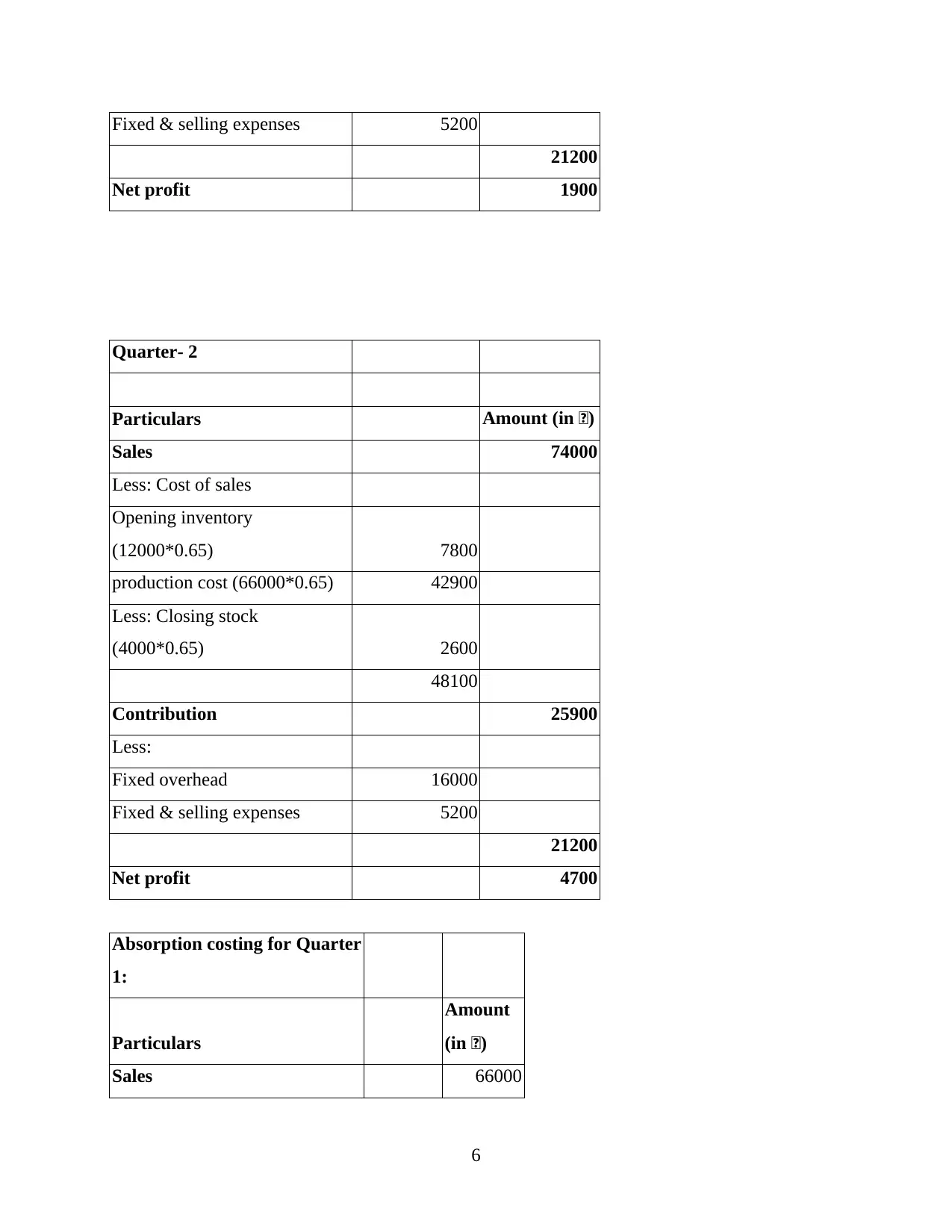
Fixed & selling expenses 5200
21200
Net profit 1900
Quarter- 2
Particulars Amount (in £)
Sales 74000
Less: Cost of sales
Opening inventory
(12000*0.65) 7800
production cost (66000*0.65) 42900
Less: Closing stock
(4000*0.65) 2600
48100
Contribution 25900
Less:
Fixed overhead 16000
Fixed & selling expenses 5200
21200
Net profit 4700
Absorption costing for Quarter
1:
Particulars
Amount
(in £)
Sales 66000
6
21200
Net profit 1900
Quarter- 2
Particulars Amount (in £)
Sales 74000
Less: Cost of sales
Opening inventory
(12000*0.65) 7800
production cost (66000*0.65) 42900
Less: Closing stock
(4000*0.65) 2600
48100
Contribution 25900
Less:
Fixed overhead 16000
Fixed & selling expenses 5200
21200
Net profit 4700
Absorption costing for Quarter
1:
Particulars
Amount
(in £)
Sales 66000
6
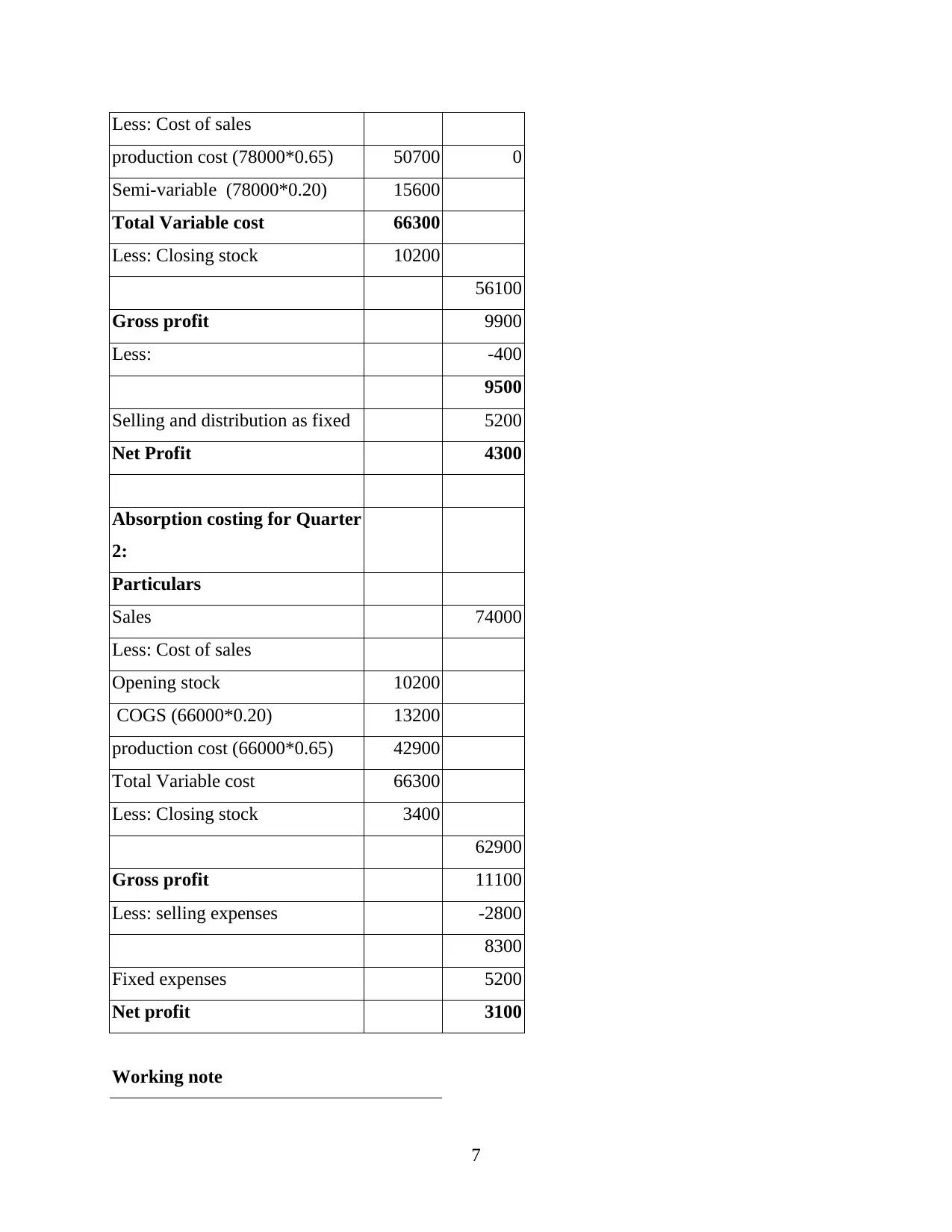
Less: Cost of sales
production cost (78000*0.65) 50700 0
Semi-variable (78000*0.20) 15600
Total Variable cost 66300
Less: Closing stock 10200
56100
Gross profit 9900
Less: -400
9500
Selling and distribution as fixed 5200
Net Profit 4300
Absorption costing for Quarter
2:
Particulars
Sales 74000
Less: Cost of sales
Opening stock 10200
COGS (66000*0.20) 13200
production cost (66000*0.65) 42900
Total Variable cost 66300
Less: Closing stock 3400
62900
Gross profit 11100
Less: selling expenses -2800
8300
Fixed expenses 5200
Net profit 3100
Working note
7
production cost (78000*0.65) 50700 0
Semi-variable (78000*0.20) 15600
Total Variable cost 66300
Less: Closing stock 10200
56100
Gross profit 9900
Less: -400
9500
Selling and distribution as fixed 5200
Net Profit 4300
Absorption costing for Quarter
2:
Particulars
Sales 74000
Less: Cost of sales
Opening stock 10200
COGS (66000*0.20) 13200
production cost (66000*0.65) 42900
Total Variable cost 66300
Less: Closing stock 3400
62900
Gross profit 11100
Less: selling expenses -2800
8300
Fixed expenses 5200
Net profit 3100
Working note
7
⊘ This is a preview!⊘
Do you want full access?
Subscribe today to unlock all pages.

Trusted by 1+ million students worldwide
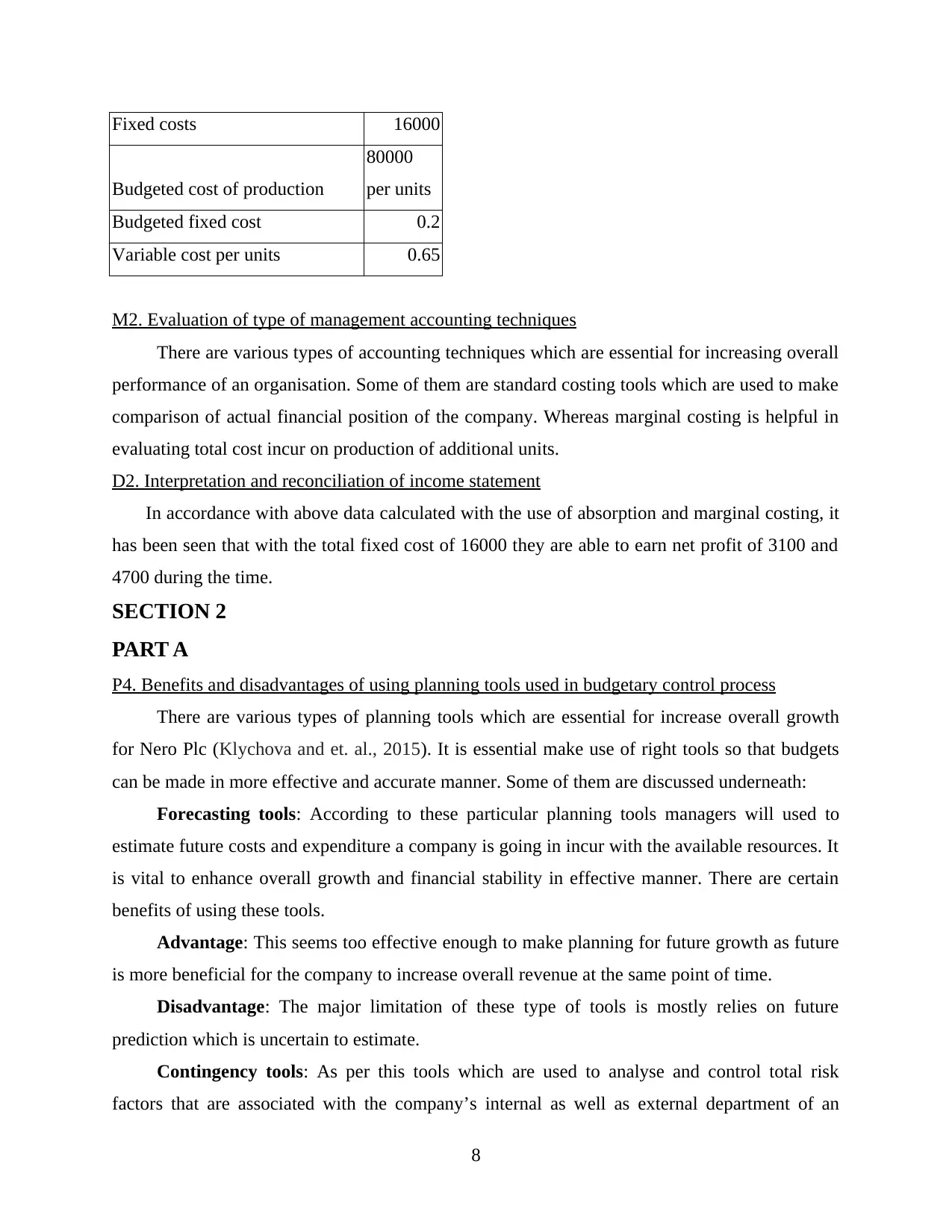
Fixed costs 16000
Budgeted cost of production
80000
per units
Budgeted fixed cost 0.2
Variable cost per units 0.65
M2. Evaluation of type of management accounting techniques
There are various types of accounting techniques which are essential for increasing overall
performance of an organisation. Some of them are standard costing tools which are used to make
comparison of actual financial position of the company. Whereas marginal costing is helpful in
evaluating total cost incur on production of additional units.
D2. Interpretation and reconciliation of income statement
In accordance with above data calculated with the use of absorption and marginal costing, it
has been seen that with the total fixed cost of 16000 they are able to earn net profit of 3100 and
4700 during the time.
SECTION 2
PART A
P4. Benefits and disadvantages of using planning tools used in budgetary control process
There are various types of planning tools which are essential for increase overall growth
for Nero Plc (Klychova and et. al., 2015). It is essential make use of right tools so that budgets
can be made in more effective and accurate manner. Some of them are discussed underneath:
Forecasting tools: According to these particular planning tools managers will used to
estimate future costs and expenditure a company is going in incur with the available resources. It
is vital to enhance overall growth and financial stability in effective manner. There are certain
benefits of using these tools.
Advantage: This seems too effective enough to make planning for future growth as future
is more beneficial for the company to increase overall revenue at the same point of time.
Disadvantage: The major limitation of these type of tools is mostly relies on future
prediction which is uncertain to estimate.
Contingency tools: As per this tools which are used to analyse and control total risk
factors that are associated with the company’s internal as well as external department of an
8
Budgeted cost of production
80000
per units
Budgeted fixed cost 0.2
Variable cost per units 0.65
M2. Evaluation of type of management accounting techniques
There are various types of accounting techniques which are essential for increasing overall
performance of an organisation. Some of them are standard costing tools which are used to make
comparison of actual financial position of the company. Whereas marginal costing is helpful in
evaluating total cost incur on production of additional units.
D2. Interpretation and reconciliation of income statement
In accordance with above data calculated with the use of absorption and marginal costing, it
has been seen that with the total fixed cost of 16000 they are able to earn net profit of 3100 and
4700 during the time.
SECTION 2
PART A
P4. Benefits and disadvantages of using planning tools used in budgetary control process
There are various types of planning tools which are essential for increase overall growth
for Nero Plc (Klychova and et. al., 2015). It is essential make use of right tools so that budgets
can be made in more effective and accurate manner. Some of them are discussed underneath:
Forecasting tools: According to these particular planning tools managers will used to
estimate future costs and expenditure a company is going in incur with the available resources. It
is vital to enhance overall growth and financial stability in effective manner. There are certain
benefits of using these tools.
Advantage: This seems too effective enough to make planning for future growth as future
is more beneficial for the company to increase overall revenue at the same point of time.
Disadvantage: The major limitation of these type of tools is mostly relies on future
prediction which is uncertain to estimate.
Contingency tools: As per this tools which are used to analyse and control total risk
factors that are associated with the company’s internal as well as external department of an
8
Paraphrase This Document
Need a fresh take? Get an instant paraphrase of this document with our AI Paraphraser
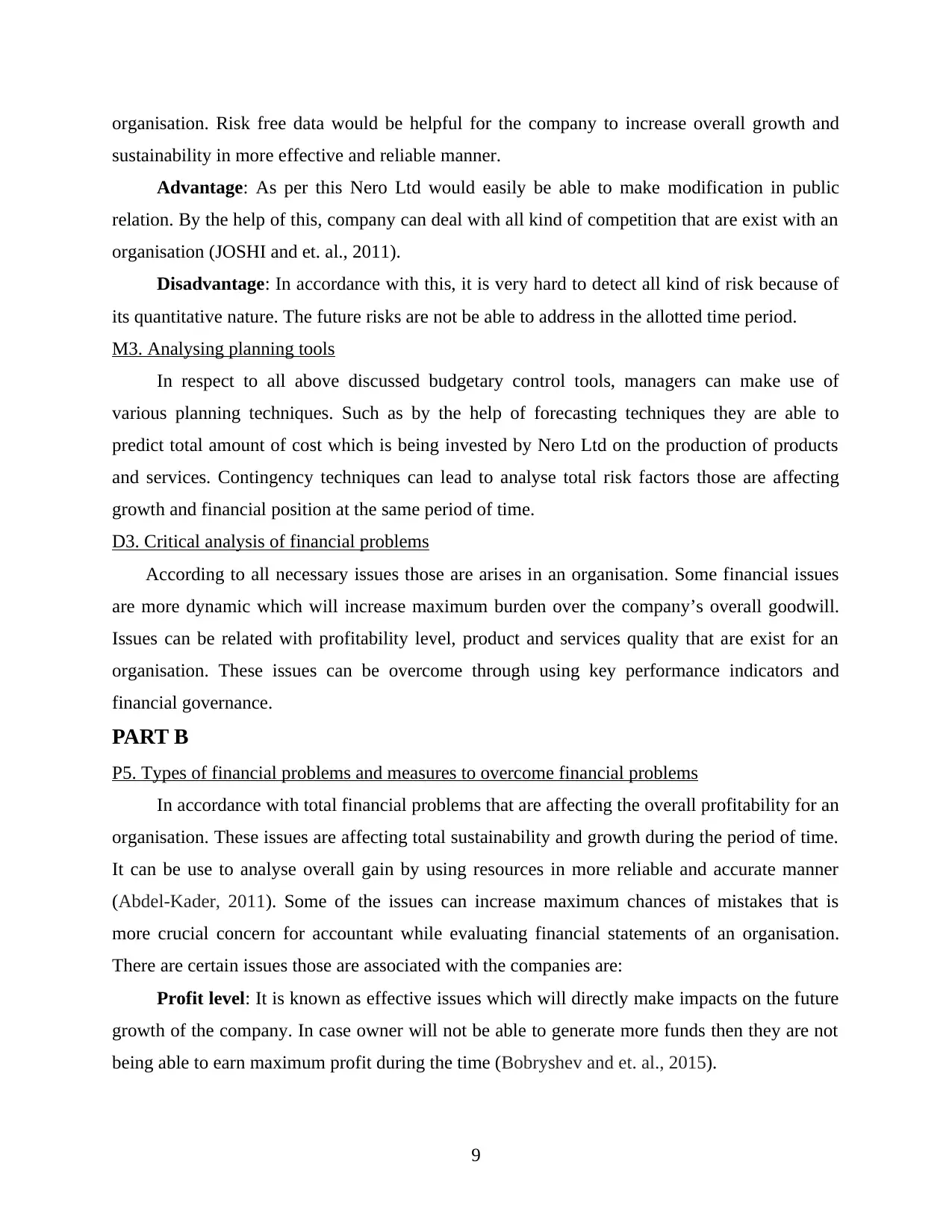
organisation. Risk free data would be helpful for the company to increase overall growth and
sustainability in more effective and reliable manner.
Advantage: As per this Nero Ltd would easily be able to make modification in public
relation. By the help of this, company can deal with all kind of competition that are exist with an
organisation (JOSHI and et. al., 2011).
Disadvantage: In accordance with this, it is very hard to detect all kind of risk because of
its quantitative nature. The future risks are not be able to address in the allotted time period.
M3. Analysing planning tools
In respect to all above discussed budgetary control tools, managers can make use of
various planning techniques. Such as by the help of forecasting techniques they are able to
predict total amount of cost which is being invested by Nero Ltd on the production of products
and services. Contingency techniques can lead to analyse total risk factors those are affecting
growth and financial position at the same period of time.
D3. Critical analysis of financial problems
According to all necessary issues those are arises in an organisation. Some financial issues
are more dynamic which will increase maximum burden over the company’s overall goodwill.
Issues can be related with profitability level, product and services quality that are exist for an
organisation. These issues can be overcome through using key performance indicators and
financial governance.
PART B
P5. Types of financial problems and measures to overcome financial problems
In accordance with total financial problems that are affecting the overall profitability for an
organisation. These issues are affecting total sustainability and growth during the period of time.
It can be use to analyse overall gain by using resources in more reliable and accurate manner
(Abdel-Kader, 2011). Some of the issues can increase maximum chances of mistakes that is
more crucial concern for accountant while evaluating financial statements of an organisation.
There are certain issues those are associated with the companies are:
Profit level: It is known as effective issues which will directly make impacts on the future
growth of the company. In case owner will not be able to generate more funds then they are not
being able to earn maximum profit during the time (Bobryshev and et. al., 2015).
9
sustainability in more effective and reliable manner.
Advantage: As per this Nero Ltd would easily be able to make modification in public
relation. By the help of this, company can deal with all kind of competition that are exist with an
organisation (JOSHI and et. al., 2011).
Disadvantage: In accordance with this, it is very hard to detect all kind of risk because of
its quantitative nature. The future risks are not be able to address in the allotted time period.
M3. Analysing planning tools
In respect to all above discussed budgetary control tools, managers can make use of
various planning techniques. Such as by the help of forecasting techniques they are able to
predict total amount of cost which is being invested by Nero Ltd on the production of products
and services. Contingency techniques can lead to analyse total risk factors those are affecting
growth and financial position at the same period of time.
D3. Critical analysis of financial problems
According to all necessary issues those are arises in an organisation. Some financial issues
are more dynamic which will increase maximum burden over the company’s overall goodwill.
Issues can be related with profitability level, product and services quality that are exist for an
organisation. These issues can be overcome through using key performance indicators and
financial governance.
PART B
P5. Types of financial problems and measures to overcome financial problems
In accordance with total financial problems that are affecting the overall profitability for an
organisation. These issues are affecting total sustainability and growth during the period of time.
It can be use to analyse overall gain by using resources in more reliable and accurate manner
(Abdel-Kader, 2011). Some of the issues can increase maximum chances of mistakes that is
more crucial concern for accountant while evaluating financial statements of an organisation.
There are certain issues those are associated with the companies are:
Profit level: It is known as effective issues which will directly make impacts on the future
growth of the company. In case owner will not be able to generate more funds then they are not
being able to earn maximum profit during the time (Bobryshev and et. al., 2015).
9
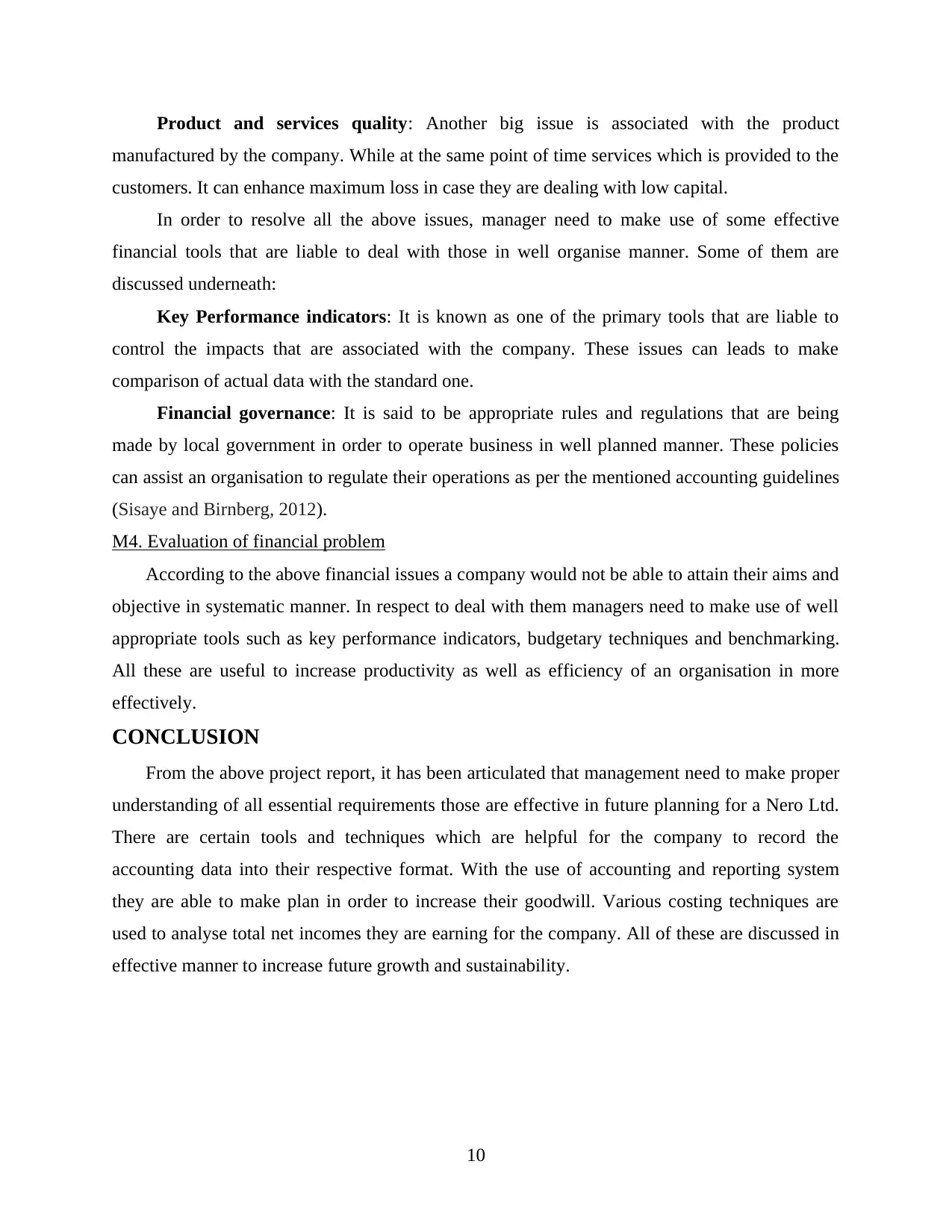
Product and services quality: Another big issue is associated with the product
manufactured by the company. While at the same point of time services which is provided to the
customers. It can enhance maximum loss in case they are dealing with low capital.
In order to resolve all the above issues, manager need to make use of some effective
financial tools that are liable to deal with those in well organise manner. Some of them are
discussed underneath:
Key Performance indicators: It is known as one of the primary tools that are liable to
control the impacts that are associated with the company. These issues can leads to make
comparison of actual data with the standard one.
Financial governance: It is said to be appropriate rules and regulations that are being
made by local government in order to operate business in well planned manner. These policies
can assist an organisation to regulate their operations as per the mentioned accounting guidelines
(Sisaye and Birnberg, 2012).
M4. Evaluation of financial problem
According to the above financial issues a company would not be able to attain their aims and
objective in systematic manner. In respect to deal with them managers need to make use of well
appropriate tools such as key performance indicators, budgetary techniques and benchmarking.
All these are useful to increase productivity as well as efficiency of an organisation in more
effectively.
CONCLUSION
From the above project report, it has been articulated that management need to make proper
understanding of all essential requirements those are effective in future planning for a Nero Ltd.
There are certain tools and techniques which are helpful for the company to record the
accounting data into their respective format. With the use of accounting and reporting system
they are able to make plan in order to increase their goodwill. Various costing techniques are
used to analyse total net incomes they are earning for the company. All of these are discussed in
effective manner to increase future growth and sustainability.
10
manufactured by the company. While at the same point of time services which is provided to the
customers. It can enhance maximum loss in case they are dealing with low capital.
In order to resolve all the above issues, manager need to make use of some effective
financial tools that are liable to deal with those in well organise manner. Some of them are
discussed underneath:
Key Performance indicators: It is known as one of the primary tools that are liable to
control the impacts that are associated with the company. These issues can leads to make
comparison of actual data with the standard one.
Financial governance: It is said to be appropriate rules and regulations that are being
made by local government in order to operate business in well planned manner. These policies
can assist an organisation to regulate their operations as per the mentioned accounting guidelines
(Sisaye and Birnberg, 2012).
M4. Evaluation of financial problem
According to the above financial issues a company would not be able to attain their aims and
objective in systematic manner. In respect to deal with them managers need to make use of well
appropriate tools such as key performance indicators, budgetary techniques and benchmarking.
All these are useful to increase productivity as well as efficiency of an organisation in more
effectively.
CONCLUSION
From the above project report, it has been articulated that management need to make proper
understanding of all essential requirements those are effective in future planning for a Nero Ltd.
There are certain tools and techniques which are helpful for the company to record the
accounting data into their respective format. With the use of accounting and reporting system
they are able to make plan in order to increase their goodwill. Various costing techniques are
used to analyse total net incomes they are earning for the company. All of these are discussed in
effective manner to increase future growth and sustainability.
10
⊘ This is a preview!⊘
Do you want full access?
Subscribe today to unlock all pages.

Trusted by 1+ million students worldwide
1 out of 13
Related Documents
Your All-in-One AI-Powered Toolkit for Academic Success.
+13062052269
info@desklib.com
Available 24*7 on WhatsApp / Email
![[object Object]](/_next/static/media/star-bottom.7253800d.svg)
Unlock your academic potential
Copyright © 2020–2025 A2Z Services. All Rights Reserved. Developed and managed by ZUCOL.





